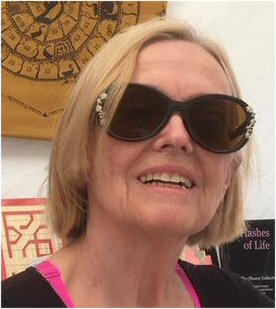6 Questions With Kate Jones

For this set of 6 Questions, I reached out to Kate Jones, of Kadon Enterprises. Kate was kind of enough to do an interview back with me when I was running OrlandoGaming.org.
She creates and publishes abstract puzzles, and runs a game shop at the Maryland Renaissance Festival.
On to the questions!
Question 1
Thanks for taking the time to answer my questions, Kate! Typically, I’d start with asking about how you became a game designer, but you already answered that (at http://www.gamepuzzles.com/orlando-gaming.htm). Instead, I’d like to narrow down a little more on what you do: abstract games. There are so many different types of games, why do you work with abstract games? What is it about them that draws you?
What draws me to abstract themes is really a philosophical matter. For as long as I can remember, back to age 2, I have looked to the essence of things to understand them. What is the starting point, the foundation, the purest form of an idea or the causal source of anything I saw or was told. Later in life I came across the concept of “singularity” and found my intellectual home there. Also later I learned how the mind works, reducing complex matters to their simplest component parts. That is how human thought “abstracts” from volumes of data to essential elements, and why we can see parallels in seemingly unrelated things. We deal with similes, metaphors, analogies to help organize data we want to integrate into our mental data bases.
Abstract ideas can be embodied in games, on game boards and game rules, in their purest form, reflecting the real world as a field of contests and conflicts to be worked out for getting to a satisfactory or winning outcome. So any abstract game system can be dressed up with dragons and trolls, fantasy landscapes and endless imaginary story lines. Likewise, any game you can name can be boiled down to its most concise abstract features.
Because I am also an artist, it pleases me to put the abstracted ideas into their purest physical form. That gives me geometric shapes and game parts with distinctive, clean lines that are irreducible, the most essential characteristics that define their nature. Whew, that’s a mouthful. And that is my pursuit, for visually and intellectually pleasing, universally true elements. That, to me, is beauty. That becomes art and a joy to play with.
Question 2
You both design your own games and publish other people’s games. How do you decide if a game is ready for publication? On the one hand, how do you know if your design is ready? On the other, how do you identify someone else’s game as being a good fit for publication?
That question touches on the crux of the dynamics of life! Human babies gestate for 9 months. Ideas may take an instant to spring to life, fully formed like Brunnhilde from the head of Wotan. Or an idea may tickle and then squirm and worm itself into one’s mind with a persistence that won’t let go, until it either ripens into full-bodied completion or eventually atrophies into forgottenness.
My shortest span to bring an idea to fruition was one afternoon. Pocket Star is a puzzle of 25 pieces that forms a coherent set and can build countless geometric patterns based on the golden ratio. A close second for speed of inspiration and briefest of perspiration is Arc Angles, also 25 pieces, with a unique combination of tiles working on the golden ratio. I recognized that both of these were ready for release the same day, because their most important features and challenges popped out immediately while still leaving a tempting open-ended world to discover with those pieces.
Then there are the sets that may take up to ten years to ripen, when enough of their possibilities have been found to make a satiating package while still leaving open questions for later. When their repertoire fills a booklet of 24 or more pages, it’s time to let them out into the world and share them with other minds. Super Roundominoes was one of these long developments. Its difficulty level intimidated me for 10 years from inflicting it on the public. Eventually I decided there were enough people “out there” who would have the fortitude to tackle tough challenges, and it has become one of our most popular sets.
So far I’ve talked about puzzles that are basic building blocks of a slice of the universe. As for games played on abstract board designs, we playtest anywhere from a day to a year or more to be sure it has no logical contradictions or bandaids required to patch aberrations or exceptions. Its “law of physics” needs to be smooth and yet leave room for endless variations and unexpected developments. Players’ ingenuity and inventiveness for maneuvers must have an infinite field of possibilities within the established game structure. And one of my main requirements is that, while a game is competitive and can have a winner, it is not to derive its goal and satisfaction from predatory or opponent-destructive motivations. Even luck is to be used rarely if at all. And the most important criterion is: Do I want to play this again? And again, and again? Boredom is anathema.
It’s not a case of wanting to play the same game for ten hours straight, over and over, since no round of a game should take more than an hour. It’s a case of wanting to come back to the game anytime, a week or month later, and still love it. Whether a game theme in its most abstract form can still be seen as a parallel to real life, whether constructing an equilibrium in constant motion or reaching a peak accomplishment within a game scenario, the players must find the time and effort spent worth it, working through a process that gives them the most satisfaction of exercising their own excellence and leaving a non-winner still happy and capable of admiring the winner’s performance and maybe learning from it to improve future skills.
I know that a design is ready when it is 100% in balance, no nagging sense of some detail not quite right. The one thing I don’t think about or worry about is what other games “out there” are the trend or fad of the moment, what has caught the public’s fancy and is currently popular. We don’t imitate. I only think about the essence of the game under consideration—does it deserve to exist? Is it timeless and universal? Will it still be a classic 500 years from now? Does it capture some essential characteristic of the laws of Nature? Does it trigger the mind to a purposeful eagerness?
I am particularly interested in a board design that is beautiful, a work of art in its own right, and we even have a name for that category: Kaleido-Matrix™ gameboards with gorgeous symmetrical grids.
As for whether someone else’s game fits, either as a game for us to publish or to sell in a guest showcase, the same criteria apply of long-term playability and aesthetic appeal. A game like Pente, Looney Labs’ Aquarius and their Fluxx variations, Murray Heasman’s Tara, and Peter Aleff’s Quantum are examples of guests we sell through our website. ThinkFun’s Pathwords, Swish Jr., Block by Block, Shape by Shape, and Square by Square are also kindred concepts we like to sell. They all make me feel good about playing them and enjoying their uniqueness. They are different from anything else. www.gamepuzzles.com/xabstrct.htm and www.gamepuzzles.com/prpuzzls.htm
Question 3
In our previous interview, you talked about where you find your inspiration for game designs. This time around, how about talking a bit about how games (and game players) have changed. Do you see any trends among younger players? With so many different entertainments competing for their time, do you find that games still pull them in?
Interesting question. As I said, we tend to ignore trends. We can see how absorbed kids (and grownups) are with smartphones and the games or puzzles presented there by the million. We don’t try to compete against them. We make and show what we love and believe in, and present them in person mainly at art shows. Right there on the counter are games and puzzles for them to try out, and their lively young minds are adventurous enough to be eager to try something new. Every now and then someone will compare our games to something they have seen elsewhere in digital form—games like Tangrams and Block Us and even pentominoes. Tangrams are centuries-old and used in classrooms. Teachers who see us recognize some mathematical similarities. Block Us is actually derived from one of our pre-existing products. It’s nice that these concepts are being popularized wholesale these days. It makes explaining our themes a little easier.
What has really changed in the last 40 years that I have been running this thinking-games enterprise is the increased technical prowess of the general audience. They understand words like tessellations and permutations, about recreational math and playing on a matrix or grid. So it has become a little easier to discuss the technical charm of our puzzles. My one blockage is still that Rubik’s cube left so many people traumatized that they are afraid of all puzzles except maybe jigsaw and crossword puzzles. They are afraid of failure, and it takes a lot of persuasion to get them to take their hands out of their pockets and try one of our puzzles where there are no wrong answers and thousands of different ones.
One amazing thing is that even younger kids, two years old and up, are tech-savvy with cellphones and want to try playing with our puzzles. Younger and younger have the focus and attention span to put puzzle pieces together. Most of my puzzles are too hard for them, but they love to tinker and enjoy the colors. But nothing I make is too easy for anyone. I see red when a visitor to my exhibit says, “Oh, this is too easy.” That’s my cue to give them an advanced challenge and watch them struggle, and sometimes become addicted. That’s when I am so pleased that all my puzzle designs have easy, medium, and very advanced levels of difficulty. Something for everyone, within the same set of pretty pieces.
Question 4
First and foremost, being a game designer means playing games. Any fun player stories?
Oh, my. Well, one of our biggest gigs each year is the Maryland Renaissance Festival, and our pavilion, Ye Olde Gamery, draws all the game players into our arcade. For a dollar a play, they can stay for hours and play every game we have on display. These folks are serious gamers even in their real lives and extensively knowledgeable of all the role-playing and Euro games. And they love what we offer. Our most popular games there are the Game of Y, Manoover, Teleporters, Power of Two, Nine Men’s Morris, Tara, Octiles, Gallop, Colormaze, Void, and the wonderfully complex Proteus. This is the ideal setting for people to learn new games, which they are all eager to do. It’s great to have so many smart players who immediately work out the best strategies and seem to enjoy greatly that these are non-predatory games.
Here’s where the fun comes in: Many times people who come into the Gamery to play eventually ask for a job with us! Even 12-year-old lads want to work for us, and it’s not for the money. A couple of 12-year-olds came on board one year as gofers to run errands, bring food and drink for our crew, and play for free when crowds thinned out. And they grew up and some still help us as part of the crew years later, having become excellent players and teachers of our games.
Question 5
You’ve been in this business for a long time, both designing and producing. What advice would you give to someone who is interested in designing games?
Hmm. My first advice is: “Don’t quit your day job.” We encounter many young people who want to design games. Some are greatly afraid that someone would steal their idea. I tell them about writing up their game and getting a copyright. Patents are not usually suitable, and they are hideously expensive. Also, finding a name for your game that is not already in use by someone is a major challenge. I have a friend who is incredibly prolific in inventing new things all the time. We have published a couple of his ideas after massaging them into viable shape. So of course I am the first to be offered anything new. In fact, not a week goes by that some enterprising designer doesn’t approach us to buy his idea. (It’s always a “his”.)
My other advice is, if you are serious about game design, get an agent who will represent you and pitch your ideas to one of the “big” game companies. Be prepared for a river of rejections, or lukewarm interest that will then go nowhere. The big boys want things that will sell well in stores and can be promoted to an existing market.
There is also the indie market, where designers self-publish and sell on a smaller scale. The bigger a splash a promotion makes, the faster it will fade. Out of 160,000 new games that come out each year (sorry, this is a statistic from decades ago), only about 16 make it into some rate of success, and only 1 may have some longevity to become a “standard”, like Scrabble or Boggle or Settlers or Risk, etc. The oldies like Candy Land, chess, checkers, Chinese Checkers, Parcheesi, Tic Tac Toe, will always be around. A new designer will also be encouraged by friends and family, with whom the first cycle of play-testing happens. That doesn’t guarantee that the big cold world out there will be receptive. Be prepared for lots of rejection, but don’t ever give up. If you believe in yourself, keep going, try Kickstarter and GoFundMe for support. But as for the pure design principle, be original. Find a need and fill it. Play on!
Question 6
You have so many different games and puzzles on your site. What’s next? Are you working on anything that you can tell us about?
Always. There is always something cooking. Right now we have 5 irons in the fire, that will have the classic Kadon touch of geometric tiles that make many gorgeous patterns and sometimes are beastly hard to solve. Until I wrestle them into one satisfactory design, their prototypes sit on the desk mocking me. (We don’t want to use a computer to find an answer. After all, our puzzles are for humans to enjoy.)
One theme that I have been pursuing for years and will keep at until I have the whole gang is to turn each of the famous 17 “Wallpaper Patterns” into a workable polyform puzzle. We already have more than half in our product line, and I’m hunting for the rest. Interested readers can look up what these 17 groups, also called symmetry groups, consist of and see which ones we’re still missing, and get to work on developing one. We pay royalties for such creativity. A polyform puzzle is a set of pieces, or tiles, that represent every different combination of their characteristic building blocks. See www.gamepuzzles.com/polycube.htm and www.gamepuzzles.com/esspoly.htm
Inventing and designing feels so good in the mind that people can make a life of it. It’s like we were born for that purpose. The same problem-solving and creative functions could also be turned to the greater issues of the world, like war and peace, health and disease, science and exploration, and benevolent resolutions of interpersonal and intergroup conflicts. Intelligence is the greatest thing to have emerged on the planet, and maybe even in the solar system. It should not be wasted. Games and puzzles are a wonderful exercise for this precious human attribute of intelligence and creativity. Make the world better, in every way you can. Build, don’t destroy. Teach peace and success through the symbolism so richly found in non-predatory games.
Speaking of which, a young associate of Kadon, Elijah Allen, has invented a game that is complex enough for the most experienced gamers and calls on occasionally collaborative strategies to prevent the destructive forces at work on the board from flooding the good folks. And it is still a beautiful abstract set design! We’re very excited about this new game and hope to have it finished by end of 2019 and publish it in time for the holidays. We’re still working on a good name for it.
Thanks, Kate!
Want to comment? Hit me up on Threads or Facebook!



